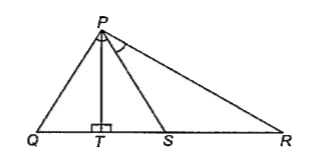PQR is a triangle, whose are is 180cm2 . S is a point on side QR, such that PS is the angle bisector of ∠QPR . If PQ : PR = 2 : 3 , then what is the area (in cm2) triangle PSR ?
90
108
144
72
The correct Answer is:B
To find the area of triangle PSR, we can use the information given in the problem along with the Angle Bisector Theorem. Here’s how we can solve it step by step:
Step 1: Understand the Problem
We have triangle PQR with an area of 180 cm². PS is the angle bisector of angle QPR, and the ratio of the lengths of sides PQ and PR is given as 2:3.
Step 2: Apply the Angle Bisector Theorem
According to the Angle Bisector Theorem, the ratio of the areas of triangles formed by an angle bisector is equal to the ratio of the other two sides. Therefore, we can express the areas of triangles PQS and PSR in terms of the ratio of PQ and PR.
Let:
- Area of triangle PQS = A1
- Area of triangle PSR = A2
According to the Angle Bisector Theorem:
A1A2=PQPR=23
Step 3: Express Areas in Terms of A2
From the ratio, we can express A1 in terms of A2:
A1=23A2
Step 4: Relate Areas to Total Area
The total area of triangle PQR is the sum of the areas of triangles PQS and PSR:
A1+A2=180 cm2
Substituting A1 from the previous step:
23A2+A2=180
Step 5: Combine Like Terms
To combine the terms, we can express A2 in a common fraction:
23A2+33A2=180
53A2=180
Step 6: Solve for A2
Now, we can solve for A2:
A2=180×35
A2=5405=108 cm2
Conclusion
The area of triangle PSR is 108 cm².
We have triangle PQR with an area of 180 cm². PS is the angle bisector of angle QPR, and the ratio of the lengths of sides PQ and PR is given as 2:3.
According to the Angle Bisector Theorem, the ratio of the areas of triangles formed by an angle bisector is equal to the ratio of the other two sides. Therefore, we can express the areas of triangles PQS and PSR in terms of the ratio of PQ and PR.
- Area of triangle PQS = A1
- Area of triangle PSR = A2
A1A2=PQPR=23
From the ratio, we can express A1 in terms of A2:
A1=23A2
The total area of triangle PQR is the sum of the areas of triangles PQS and PSR:
A1+A2=180 cm2
23A2+A2=180
To combine the terms, we can express A2 in a common fraction:
23A2+33A2=180
53A2=180
Now, we can solve for A2:
A2=180×35
A2=5405=108 cm2
The area of triangle PSR is 108 cm².
Similar Questions
Knowledge Check
- Question 1 - Select One
In a triangle PQR, PX bisects QR. PX is the angle bisector of angle P. If PQ=12 cm and QX=3 cm, then what is the area (in cm2) of triangle PQR?
A12√3B8√15C18√2D9√15 - Question 2 - Select One
In Δ PQR,PS is the bisector of ∠PandPT⊥QR, where ∠ Q = 60 and ∠R = 30 then ∠TPS is equal to
 A10B30C60D15
A10B30C60D15 - Question 3 - Select One
PQR is a right angled triangle at Q in which PQ = QR. If the hypotenuse of the triangle is 20 cm, then what is the area (incm2) of the triangle PQR ?
A100√2B100C50√2D50
S is the incentre of △PQR . If ∠PSR=125∘, then the measure of ∠PQR is:
View SolutionIf Q is a point on the side SR of a triangle PSR such that PQ=PR then prove that PS>PQ
View SolutionPQRSis a rectangle in which side of PQ=24cm. and QR=16cm. T is a point on RS. What is the area (in cm.) of the triangle PTQ?
View SolutionΔPQR is right angled at point Q. If PQ=8cmand PR=(QR+2)cm. What is the value (in cm) of PR?
View SolutionIn ΔPQR measure of angle Q is 90∘. If cosP = 5/13, and PQ = 2.5cm, then what is the length (in cm) of side PR?
View Solution

